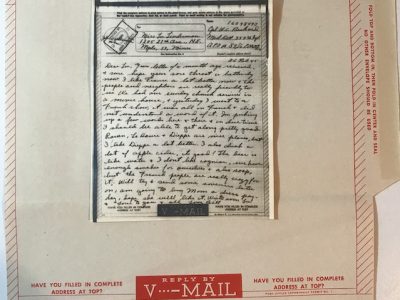One of the most important events in military life is mail from home! This is never more crucial than in time of war, with troops serving overseas and in harm’s way. The effect mail has on morale can often be the difference between success and failure. With millions of US troops overseas during WW ll, delivery of the mail was a top priority. This created a logistical dilemma. Mail had to compete with priority shipments of food, munitions, fuel, medical supplies and other material necessary to wage war. Enter the iconic V Mail!
The troops overseas and their families and friends on the home front used pre-printed, standardized forms to write letters. These folded into their own envelope and once mailed, the letters were routed to a central station. Photos of the letters were taken and placed on microfiche. The original letters were then destroyed. Rather than transporting thousands of letters to the war zone, they simply transported rolls of microfiche! When the microfiche reached its destination, it was again routed to a central station where the film was developed, printed in a version smaller than the original V Mail form, and delivered to the addressee. To put it in perspective, the weight of 150,000 single-page letters was reduced from 2,575 pounds to 45 pounds, thereby freeing up essential space needed to transport the materials of war.
In addition, the V Mail forms helped facilitate censorship, thereby enhancing security. During the Second World War, mail sent back to the US from overseas was rigorously censored. Officers, shouldering the responsibility of command, were entrusted to self-censor. But all mail coming from enlisted men was censored before leaving the sender’s unit. An additional hurdle was faced by soldiers who were foreign born, or the children of foreign-born parents. It was often easier for them to write to their families in their native language, but to no avail. If a soldier wrote to their parents in Italian and no officer was available who could read it, these letters were simply destroyed. If the soldier was lucky, they were told “Write in English or don’t write at all.”



0 comments on “WW II’s version of emails from the front”